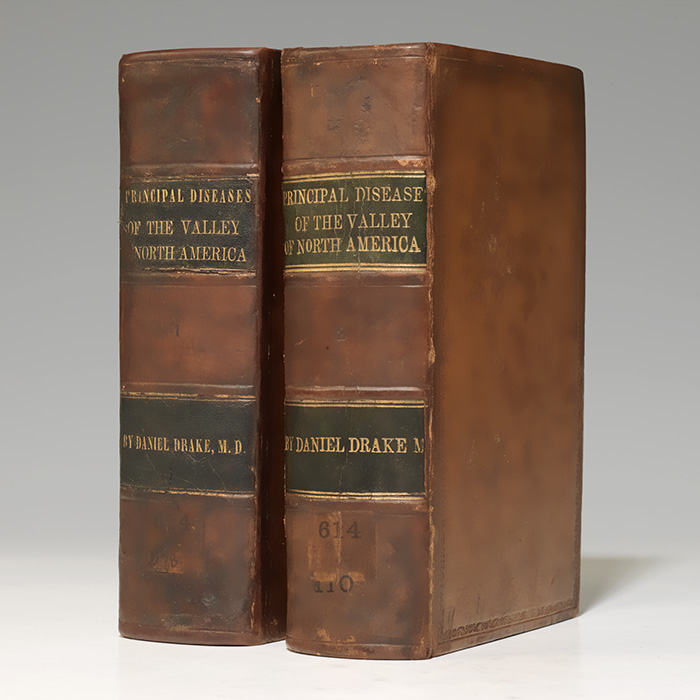
RARE COMPLETE TWO-VOLUME PRESENTATION COPY OF DRAKE'S LANDMARK STUDY OF NORTH AMERICAN DISEASES, "AN EPIC STUDY OF THE PHYSICAL STATE OF THE NATION DURING THE DECADES OF THE WESTWARD MOVEMENT," TWICE INSCRIBED IN THE YEAR OF PUBLICATION IN VOLUME I TO DRAKE'S FRIEND, DR. ALFRED STILLE, A PHILADELPHIA PHYSICIAN WHO PLAYED A LEADING ROLE IN ESTABLISHING THE DIFFERENCE BETWEEN TYPHUS AND TYPHOID FEVER, IN CONTEMPORARY CALF
DRAKE, Daniel. A Systematic Treatise, Historical, Etiological and Practical, on the Principal Diseases of the Interior Valley of North America, as they appear in the Caucasian, African, Indian and Esquimaux Varieties of its Population. Cincinnati and Philadelphia: Winthrop B. Smith and Lippincott, 1850-54. Two volumes. Thick octavo, contemporary full brown calf, raised bands, black and green morocco spine labels. Housed together in a custom half morocco solander box. $16,500.
First edition, presentation copy, of Drake's groundbreaking study of North American diseases, with 19 maps (one folding) and numerous in-text tables, inscribed on the title page of Volume I in the year of publication to his friend Dr. Alfred Stille, a leading Philadelphia doctor known for his work differentiating typhus and typhoid fever and his landmark text on pathology: "To Dr. Alfred Stille with the regards of his friend, Cincin[nati]. May 11th, 1850, Dan Drake," and with an additional pencil inscription on the dedication leaf reading: "To Dr. Stille with the respects of the author." Complete two-volume sets of this work are quite rare, particularly in contemporary calf.
"Drake's heroic subject was the North American continent: its topography, meteorology, and ethnology as they related to the health of its people. In the preface to this monumental work, he stated that he had begun research 40 years previously to make personal observation from Florida to Canada of the diseases prevailing in the midlands of the continent, into which men of European origin and their African slaves were rapidly spreading. This is an epic record of the physical state of the nation during the decades of the westward movement and offers a physician's view of health and sickness among the peoples of a vast and diversified region" (Lilly, Notable Medical Books, 203). "It is a mine of information… characterized by the most painstaking accuracy of statement, a graceful and clear style, a most unprejudiced and scientific weighing of evidence, and great caution in references" (DAB). "This classical contribution to the social history of North America includes the most important work on the natural history of malaria published up to that time" (Garrison & Morton 1777). Complete two-volume copies of this work are quite rare. Volume II was posthumously edited and issued by a different publisher in a different city four years after the publication of the first volume. Accordingly, contemporary sets in matching binding, like this one, are rarely seen. Howes D469 (b). Sabin 20805. This work is twice inscribed by Drake to Dr. Alfred Stille in Volume I and also bears Stille's bookplate. Stille was a prominent Philadelphia physician who divided his efforts between practicing medicine; promoting the science of pathology; conducting medical research; and advocating for the reform of medical education of American (still quite rudimentary in the 19th century). Stille's professional accomplishments were considerable. Perhaps most notably, given the era in which he lived, Stille played a critical role in establishing that typhus and typhoid fever were separate medical conditions. He also wrote the first American book on pathology, Elements of General Pathology. While Stille, like many of his contemporaries, would eventually stumble when confronted with germ theory, his "teaching and research consistently advocated clinical observation, medical statistics, and hospital practice." His influence was keenly felt during his time as president of the American Medical Association—an organization he helped to found—and as vice president of the Centennial Medical Commission. In these positions, Stille was able to introduce his colleagues and students to the work of men such as Drake. Clearly an enthusiast of cutting-edge medicine, Stille reported on the first volume of Drake's Treatise on the Diseases of North America—quite possibly relying on this very copy—for the American Medical Association in 1850. There, he "was greeted with prolonged and thunderous demonstrations of enthusiasm and applause, such as had seldom been accorded to any physician before" (Garrison, 442). Ex-libris, University of Pennsylvania, The Stille Library, with spine labels, bookplates, title page stamps, and numerous other library markings.
Mild toning to plates, wear to contemporary calf, Volume I rebacked with original spine laid down. An extremely good copy, twice inscribed with a fascinating provenance.